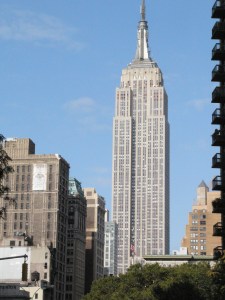
Jason Black has found that going green can become a habit.
The director of architecture and sustainability for Reckson, a division of SL Green, said the firm began its green initiatives by recycling carpet and ceiling tiles in its suburban office portfolio, then graduated to lighting retrofits and to installing a solar roof on one of its office buildings in Greenwich, Conn. Finding savings in one area emboldened the firm to find “green savings” in other areas, and Mr. Black said Reckson’s portfolio of suburban properties is being used as a proving ground for measures that could eventually be adopted in SL Green’s New York City ones.
Other building owners may also get into the habit. Whereas such development could sometimes mean waiting 10 to even 15 years for a noticeable payoff, a confluence of factors, ranging from improved and cheaper green building products, greater knowledge on how to make these projects pay and, ironically, the slowdown in New York City construction, has meant that more green new buildings and retrofit projects can pay dividends in a three-to-five-year horizon.
“A lot of significant measures don’t have a 10- or a 15-year payback period,” said Katie Rothenberg, manager of commercial real estate for the U.S. Green Building Council. “The more you know, the more feasible it becomes.”
Some green building initiatives can be implemented for minimal cost and produce an almost immediate payback, according to Robert Bolin, senior vice president at Syska Hennessy Group. For example, a building can introduce a “smart lighting” system-which encompasses daylight-responsive and occupancy-sensor lighting-that can save on energy because less lighting is used and the air-conditioning loads drop, because rooms are cooler when lights are off, he said.
“This is a simple double whammy,” Mr. Bolin said. “This is low-hanging fruit that provides an almost immediate payback.”
A LIGHTING RETROFIT at 21 Reckson properties, completed in May 2009, in Westchester and Fairfield counties replaced older, three-lamp lighting fixtures with two-lamp fixtures that emitted 40 percent more light, thus enabling Reckson to reduce the amount of fixtures needed. The project cost $1.4 million to do, but means an energy savings of $500,000 a year, or about a 1.4-year payback, when incentives from the New York State Energy Research and Development Authority (NYSERDA) and Connecticut Light and Power are figured into the equation, Mr. Black said.
Building owners can also receive fairly fast and generous returns if they commission their building, which involves a run-through of all of a building’s mechanical systems to see if they are operating at peak energy efficiency, Ms. Rothenberg said.
A 2004 study conducted by the Lawrence Berkeley National Laboratory, Portland Energy Conservation, Inc. and the Energy Systems Laboratory found that for existing buildings, commissioning costs were 27 cents per square foot, with the end result an energy savings of 15 percent, translating to a payback in seven months. “You’re talking about getting a payback for this in under a year,” Ms. Rothenberg said. “That’s a no-brainer.”
Reckson’s payback on its solar roof will take longer. The solar roof on the Greenwich building, completed earlier this year, will provide approximately 5 percent of the building’s annual energy needs, and counting state and federal incentives, including some from the Connecticut Clean Energy Fund, the payback will occur in a 4.5-to-5-year time frame. The panels will allow the building to reduce its peak load energy demand because of its on-site energy-generation capacity, Mr. Black said, and he believes that there will be opportunities to use solar power at some of SL Green’s New York City buildings.
“We’re definitely looking at opportunities down the road,” he said.
However, Mr. Bolin of Syska Hennessy says that some highly visible green energy markers, such as solar panels and wind turbines, typically have long payback periods that can range from 10 to 15 years. He points out that the Empire State Building will have a much shorter payback period with its headline-making retrofit. The iconic building, which will reduce its energy usage by 38 percent when the retrofit is completed, will contain neither solar panels nor wind turbines.


